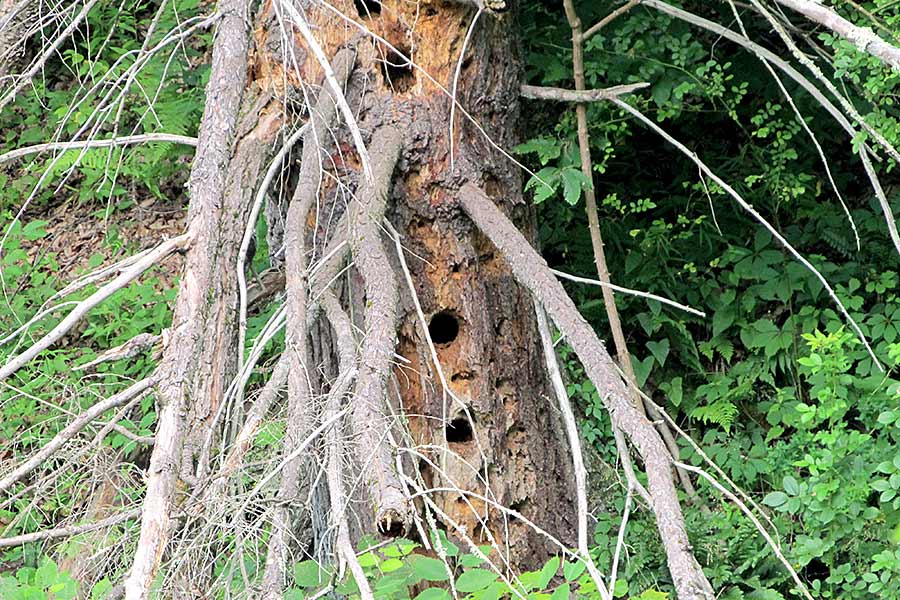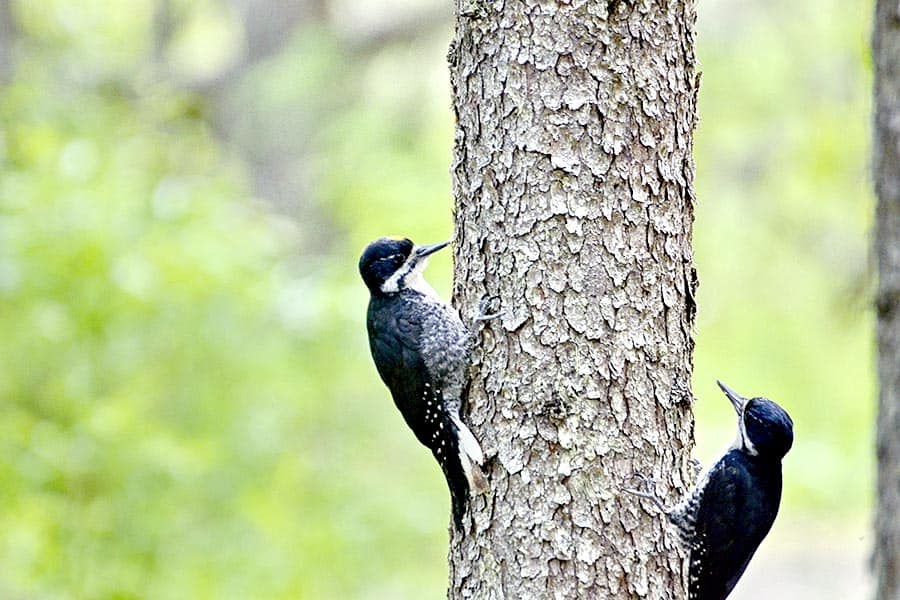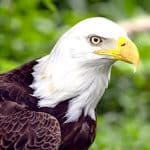
Let’s journey into the heart of Pennsylvania’s lush forests, home to a fascinating variety of woodpeckers. These drummers of the forest display an array of captivating behaviors and adaptations that make them a joy to observe and study.
From the rhythmic hammering echoing through the woods to their vibrant plumage, these birds are integral to Pennsylvania’s diverse ecosystem. In this post, we’ll delve into the captivating world of Pennsylvania’s woodpeckers, providing you with detailed insights into their species, habits, and unique characteristics.
Woodpeckers: The Heartbeat of the Forest
Enveloped in the thick woodland, the state’s woodpeckers serve as the living depiction of nature’s balanced harmony. Let’s familiarize ourselves with some of these remarkable species:
1. Downy Woodpecker

The Downy Woodpecker is a small, charismatic bird that adds charm to the forests and backyards of North America. Known for its agility and distinctive drumming, this bird holds a vital role in our woods.
They are the littlest woodpeckers in North America, adorned with a classic black-and-white coloration and a straight, chisel-like bill. Males can be distinguished from females by a small red patch on the back of their heads.
These birds are known for their acrobatic movements, often seen balancing on slender plants, sycamore seed balls, and suet feeders. It skillfully maneuvers slender plant stems and tiny branches, displaying a level of agility that’s truly mesmerizing. Their distinct rhythmic drumming resonates through the forest, serving as a beacon for birdwatchers and nature lovers.
Despite its small size, it boasts an impressive diet, feeding on a wide range of insects, including beetles, ants, and caterpillars. Notably, it also enjoys seeds and berries, making it essential to controlling pest populations and aiding in seed dispersal.
Nesting within the cavities of trees, it exhibits fascinating behaviors. From courtship rituals involving head-bobbing and wing-flicking to the diligent feeding of their young, these birds offer endless opportunities for observation and study.
2. Hairy Woodpecker

The Hairy Woodpecker is a medium-sized bird bearing a strong resemblance to its smaller cousin, the Downy Woodpecker, and it is characterized by its bold black-and-white plumage and a prominent red patch on the head of males.
These birds are known for their agile movements as they forage along trunks and main branches of large trees. They typically hitch up tree trunks, leaning back against their stiff tail feathers and springing upward with both feet at once.
This bird thrives in the state’s dense forests, where its drumming echoes as a natural symphony. Its powerful, rhythmic pecking not only aids in foraging along tree trunks and large branches but also serves as a communication tool and a means of establishing territory.
This remarkable bird boasts an adaptable diet, primarily feeding on insects hidden in the bark of trees, particularly wood-boring beetles and their larvae, ants, as well as fruits and nuts. This diet makes them crucial players in controlling pest populations and preserving the health of trees. Such dietary diversity enables it to flourish across different habitats and seasons, contributing to its widespread presence throughout the state.
It excavates cavities in trees, often reusing the same holes for multiple breeding seasons. Carved with precision and care, these nests provide a safe haven for their young and are sometimes adopted by other cavity-nesting species.
3. Red-bellied Woodpecker

The Red-bellied Woodpecker is a remarkable bird that adds a dash of color and rhythm to the woodlands of the Keystone State. Known for its vibrant plumage and distinctive calls, this bird is an unmissable sight with its strikingly contrasting colors.
They are medium-sized with a distinctive barred pattern on their back and wings. While their name might suggest otherwise, the most noticeable color on their body is not red but a bright, zebra-like black and white pattern.
The red part of their name comes from the blush of red on their belly, which is often hard to see. Males have a full red cap starting from the forehead, while females only have red on the nape of the neck.
These birds are quite vocal, and their loud, rolling calls are a common sound in their habitats. They’re also known for their agility, moving up and down tree trunks effortlessly in search of food.
Native to the deciduous forests of the state, it thrives in the region’s dense foliage. Their rhythmic drumming, a signature trait, not only serves as an auditory delight but also plays a crucial role in their communication and territory marking.
Their diet is as diverse as their vibrant plumage. They are omnivorous, feeding on insects, fruits, nuts, and sometimes even small amphibians and birds.
Their feeding habits contribute to controlling pest populations and seed dispersal, enhancing forest health. This dietary versatility allows them to adapt to changing seasons and food availability, contributing to their widespread presence across Pennsylvania.
They carve out holes in dead or decaying trees, use an abandoned hole from other woodpeckers, natural cavities, or even nest boxes for their young ones.
4. Pileated Woodpecker

The Pileated Woodpecker is a captivating bird, well-known for its flamboyant appearance and distinct hammering sound. As one of the largest woodpeckers in North America, it plays a significant role in the ecosystem.
The Pileated Woodpecker is instantly recognizable with its size, nearly as large as a crow, and its bold black and white plumage contrasted by a brilliant red crest. Both males and females bear this crest, though a red stripe on the cheek distinguishes males.
These birds are primarily solitary, living in mature forests and swamps where dead trees are abundant. They’re known for their characteristic rectangular holes in tree trunks, which they excavate to find their preferred diet of carpenter ants and wood-boring beetle larvae.
Its feeding habits help control pest populations, and the holes they carve out provide homes for many other species, such as owls, bats, and ducks. In essence, they are considered ‘ecosystem engineers.’
Although they aren’t currently threatened, habitat loss due to deforestation is a concern. Public awareness and conservation efforts are crucial to ensure their population remains stable.
Keystone Answers Fun Fact: Published initially in 1934 with illustrations by Roger Tory Peterson, a native of Jamestown, New York, ‘A Field Guide to the Birds of Eastern North America’ provided bird enthusiasts with a practical tool for swiftly and correctly identifying birds while out in the field.
5. Yellow-shafted Northern Flicker

The Yellow-shafted Northern Flicker or sometimes called the Common Flicker, is a remarkable member of the woodpecker family, captivating bird enthusiasts with its brilliant plumage and unique behaviors. Its distinct traits make it stand out in the state’s forests and backyards alike.
Flickers are large, brown birds adorned with handsome black-scalloped plumage. Their underwings and tail flash bright yellow when they fly, creating a stunning display. It also has a notable white rump patch that is noticeable when it flies. Unlike many woodpeckers, Northern Flickers often forage on the ground, seeking ants and beetles with their long, slightly curved beaks.
Males are distinguished by a black mustache stripe extending from the beak. Their characteristic calls and short bursts of drumming echo through the forests, particularly in spring.
Northern Flickers primarily feed on ants and beetles, digging into the ground with their beaks to find these insects. They also enjoy fruits and berries, making them beneficial for seed dispersal.
Their feeding habits contribute to pest control, while their nesting excavations provide homes for various other bird species, enhancing the biodiversity of their habitats.
6. Red-headed Woodpecker

The Red-headed Woodpecker adds a stunning splash of color to the forests and woodlands of the state. Known for its vibrant red head and contrasting body plumage, it is the only woodpecker in the US with an entirely red head.
They are medium-sized with a vivid appearance. Their entire head and neck are a brilliant shade of red, contrasted by a stark black-and-white pattern on their wings and tail. Both males and females share the same colorful markings, making them one of the most easily identifiable.
These birds are known for their bold behavior, often defending their territory against much larger birds. They’re also one of the few woodpecker species adept at catching insects in flight.
Red-headed Woodpeckers have a varied diet, feeding on insects, earthworms, seeds, nuts, fruits, and occasionally even the eggs of other birds. Their feeding habits contribute to controlling pest populations and seed dispersal, thereby maintaining forest health.
Their nest cavity can be found in a bare, dead tree or a lifeless branch, situated anywhere from a few feet off the ground to as high as 65 feet or more.
While they were once abundant, their populations have declined significantly over the past few decades due to habitat loss and competition for nest sites. They’re currently listed as Near Threatened by the International Union for Conservation of Nature (IUCN), underscoring the importance of conservation efforts.
7. Yellow-bellied Sapsucker

The Yellow-bellied Sapsucker is a unique member of the woodpecker family, known for its distinctive feeding habits and the fascinating patterns it creates on tree trunks. This species adds an intriguing dimension to the forests of Pennsylvania.
Yellow-bellied Sapsuckers are medium-sized adorned with black, white, and yellow feathers. Their most distinguishing feature is the pale yellow wash on their belly. Males have a red crown and throat, while females only have a red crown.
These birds are famous for their methodical behavior, often leaving neat rows of small holes in the bark of trees. They’re relatively quiet but can be heard making a cat-like mew sound, particularly during mating season.
Unlike most woodpeckers, Yellow-bellied Sapsuckers primarily feed on tree sap. They drill holes into the bark of trees to get to the sap and consume insects attracted to it. This unique feeding habit plays a role in the environment by providing food for other animals that feed on sap.
They usually nest in deciduous trees and like trees affected by tinder fungus. More often than not, they return to the same tree, but usually not the same hole every year. Both sexes work on excavating the nest cavity.
Yellow-bellied Sapsuckers are common and widespread, but habitat loss and changes in tree composition due to human activities pose potential threats.
8. Black-backed Woodpecker: A Rare but Fascinating Visitor to Pennsylvania

The Black-backed Woodpecker is an intriguing bird known for its black plumage and preference for burnt forests. While primarily found in the boreal forests of Canada and the western mountains of the United States, it occasionally graces Pennsylvania with its presence.
They are medium-sized with a distinctive black back and tail. Their white undersides and males’ yellow crown create a stunning contrast, making them easy to identify. They are known for their resilience, often thriving in areas affected by forest fires or other disturbances.
They are solitary creatures, each living within its own territory. Their drumming sound, used for communication and finding food, adds a unique rhythm to the forest’s soundscape.
Black-backed Woodpeckers primarily feed on wood-boring beetle larvae found in deadwood trees. This diet makes them crucial players in controlling insect populations and promoting forest health.
Their nests are in dead or dying trees, typically in a conifer, and are usually 2-15′ above ground, rarely 50′ or higher. Most of the time, they clear the bark away from the hole opening.
In Pennsylvania, the Black-backed Woodpecker is an occasional visitor rather than a permanent resident. Sightings are rare but exciting for bird enthusiasts, as they offer a glimpse into the life of this remarkable bird.
Nature’s Drummers
Every woodpecker species adds a distinct touch of allure and personality, enriching the diverse mosaic of Pennsylvania’s woodland habitats.
What distinguishes these forest maestros is their remarkable drumming talent. Much like accomplished drummers, they employ their sturdy beaks to produce a rhythmic beat that echoes across the woodland. This drumming plays various roles, serving as a communication method, a territorial marker, and even a strategy for gathering nourishment.
In the realm of communication, woodpeckers utilize their drumming abilities to lure partners, claim territories, and alert others of potential threats. Each species has a unique drumming rhythm, facilitating clear communication among the same species. By emitting strong vibrations into tree trunks, these bird virtuosos establish a form of expression understood solely by their woodpecker brethren.
Territorial clashes in the bird kingdom can get intense, and woodpeckers are certainly part of this. Instead of resorting to physical confrontations, these intelligent birds use their drumming skills for territorial assertion. The powerful beats reverberate through the woodland, establishing authority and deterring potential intruders, promoting harmonious living within their forested territories.
However, their rhythmic capabilities extend beyond that. These ingenious birds also employ their drumming to expose hidden gems within tree barks. Each accurate peck of their beak unveils a rich banquet of insects and larvae concealed below the surface. This distinctive feeding method enables them to flourish in their forest environment and plays a vital role in maintaining ecological equilibrium.
Not only are Pennsylvania’s woodpeckers gifted drummers, but they’re also devoted builders. Their capacity to hollow out tree cavities plays a crucial role in the functioning of the forest ecosystem. These spaces serve as safe havens and nesting grounds for a diverse array of other birds, small mammals, and even insects. Through their ceaseless drumming and excavation, they mold the essence of their surroundings, leaving an indelible mark on the complex pattern of woodland life.
The Beat Goes On
In conclusion, the woodpeckers of Pennsylvania are not just inhabitants of the forest but active contributors to its rhythm and vitality. As skilled drummers and dedicated builders, they play an integral role in shaping their woodland home.
Their rhythmic beats serve as a unique language, a territorial marker, and a method for uncovering food, while their architectural skills provide shelter for a host of other creatures. The drumming of Pennsylvania’s woodpeckers is indeed the heartbeat of our forests, echoing a testament to nature’s intricate and dynamic balance.






